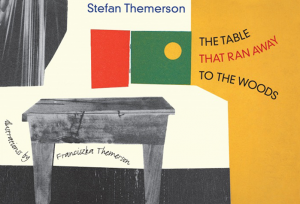 This small format picture book written in 1930’s poignantly tells the story of how the author’s writing desk puts on two pairs of shoes, (a pair belonging to him and a pair belonging to his wife) and takes off down the stairs out of a man-made urban environment and back to the woods where it takes root.
This small format picture book written in 1930’s poignantly tells the story of how the author’s writing desk puts on two pairs of shoes, (a pair belonging to him and a pair belonging to his wife) and takes off down the stairs out of a man-made urban environment and back to the woods where it takes root.
The illustrations were created by the author’s wife Franciszka Themersen. Her technique is collage and photomontage. Images from magazines, and flat colour are in interspersed with hand drawn line on cut-out scraps of paper. Collage with it’s collision of different techniques draws attention to the process of it’s making. Rather than allowing us to become immersed in the illustration it continually draws us back to the surface of the page. The images of the urban scenes are black and white, jagged shapes and cuts outs of concrete brutalist buildings. Colour is rare: the window on the cover, the green leaves, selected words in the text – it’s a welcome relief from the harsh black.
The book is unsettling. There are so many conflicts and contrasts, jarring imagery induces the sense of anxiety the author might have felt at the beginning of an era where war threatens to destroy everything worth fighting for and modernity threatens to turn nature into a resource.
Is there a conflict between nature and culture?
Is culture natural?
Is the state of nature something perfect to be protected from the polluting influence of culture? (Rousseau)
It also raises philosophical questions regarding environmental ethics, modernity’s anthropocentric view of nature as resource.
Is nature simply there for us to do as we please with?
Is it right that human affairs spill out to the detriment of other living things?
The images of branches springing from where the ink has been spilled and the starlings nesting in the inkwell raise questions around language. The starlings in ink seems reminiscent of birds drenched in oil.
Do words restrict, and therefore distort/pollute ideas?
And yet, the word starling suggests the birth of an idea. It’s the fertility of the authors imagination that’s sprouted branches and is about to take flight, remaking the world.
How can ideas (something non physical that arise in the mind) alter the world physically?
